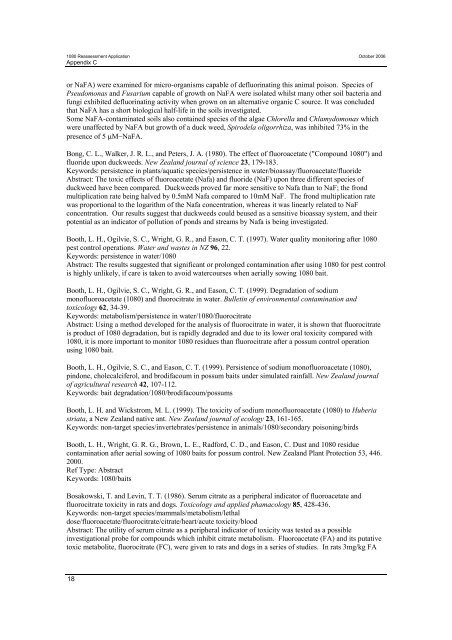Source: Landcare Research (1964). Control of poisons. Royal ...
Source: Landcare Research (1964). Control of poisons. Royal ...
Source: Landcare Research (1964). Control of poisons. Royal ...
Create successful ePaper yourself
Turn your PDF publications into a flip-book with our unique Google optimized e-Paper software.
1080 Reassessment Application October 2006<br />
Appendix C<br />
or NaFA) were examined for micro-organisms capable <strong>of</strong> defluorinating this animal poison. Species <strong>of</strong><br />
Pseudomonas and Fusarium capable <strong>of</strong> growth on NaFA were isolated whilst many other soil bacteria and<br />
fungi exhibited defluorinating activity when grown on an alternative organic C source. It was concluded<br />
that NaFA has a short biological half-life in the soils investigated.<br />
Some NaFA-contaminated soils also contained species <strong>of</strong> the algae Chlorella and Chlamydomonas which<br />
were unaffected by NaFA but growth <strong>of</strong> a duck weed, Spirodela oligorrhiza, was inhibited 73% in the<br />
presence <strong>of</strong> 5 µΜ−NaFA.<br />
Bong, C. L., Walker, J. R. L., and Peters, J. A. (1980). The effect <strong>of</strong> fluoroacetate ("Compound 1080") and<br />
fluoride upon duckweeds. New Zealand journal <strong>of</strong> science 23, 179-183.<br />
Keywords: persistence in plants/aquatic species/persistence in water/bioassay/fluoroacetate/fluoride<br />
Abstract: The toxic effects <strong>of</strong> fluoroacetate (Nafa) and fluoride (NaF) upon three different species <strong>of</strong><br />
duckweed have been compared. Duckweeds proved far more sensitive to Nafa than to NaF; the frond<br />
multiplication rate being halved by 0.5mM Nafa compared to 10mM NaF. The frond multiplication rate<br />
was proportional to the logarithm <strong>of</strong> the Nafa concentration, whereas it was linearly related to NaF<br />
concentration. Our results suggest that duckweeds could beused as a sensitive bioassay system, and their<br />
potential as an indicator <strong>of</strong> pollution <strong>of</strong> ponds and streams by Nafa is being investigated.<br />
Booth, L. H., Ogilvie, S. C., Wright, G. R., and Eason, C. T. (1997). Water quality monitoring after 1080<br />
pest control operations. Water and wastes in NZ 96, 22.<br />
Keywords: persistence in water/1080<br />
Abstract: The results suggested that significant or prolonged contamination after using 1080 for pest control<br />
is highly unlikely, if care is taken to avoid watercourses when aerially sowing 1080 bait.<br />
Booth, L. H., Ogilvie, S. C., Wright, G. R., and Eason, C. T. (1999). Degradation <strong>of</strong> sodium<br />
mon<strong>of</strong>luoroacetate (1080) and fluorocitrate in water. Bulletin <strong>of</strong> environmental contamination and<br />
toxicology 62, 34-39.<br />
Keywords: metabolism/persistence in water/1080/fluorocitrate<br />
Abstract: Using a method developed for the analysis <strong>of</strong> fluorocitrate in water, it is shown that fluorocitrate<br />
is product <strong>of</strong> 1080 degradation, but is rapidly degraded and due to its lower oral toxicity compared with<br />
1080, it is more important to monitor 1080 residues than fluorocitrate after a possum control operation<br />
using 1080 bait.<br />
Booth, L. H., Ogilvie, S. C., and Eason, C. T. (1999). Persistence <strong>of</strong> sodium mon<strong>of</strong>luoroacetate (1080),<br />
pindone, cholecalciferol, and brodifacoum in possum baits under simulated rainfall. New Zealand journal<br />
<strong>of</strong> agricultural research 42, 107-112.<br />
Keywords: bait degradation/1080/brodifacoum/possums<br />
Booth, L. H. and Wickstrom, M. L. (1999). The toxicity <strong>of</strong> sodium mon<strong>of</strong>luoroacetate (1080) to Huberia<br />
striata, a New Zealand native ant. New Zealand journal <strong>of</strong> ecology 23, 161-165.<br />
Keywords: non-target species/invertebrates/persistence in animals/1080/secondary poisoning/birds<br />
Booth, L. H., Wright, G. R. G., Brown, L. E., Radford, C. D., and Eason, C. Dust and 1080 residue<br />
contamination after aerial sowing <strong>of</strong> 1080 baits for possum control. New Zealand Plant Protection 53, 446.<br />
2000.<br />
Ref Type: Abstract<br />
Keywords: 1080/baits<br />
Bosakowski, T. and Levin, T. T. (1986). Serum citrate as a peripheral indicator <strong>of</strong> fluoroacetate and<br />
fluorocitrate toxicity in rats and dogs. Toxicology and applied phamacology 85, 428-436.<br />
Keywords: non-target species/mammals/metabolism/lethal<br />
dose/fluoroacetate/fluorocitrate/citrate/heart/acute toxicity/blood<br />
Abstract: The utility <strong>of</strong> serum citrate as a peripheral indicator <strong>of</strong> toxicity was tested as a possible<br />
investigational probe for compounds which inhibit citrate metabolism. Fluoroacetate (FA) and its putative<br />
toxic metabolite, fluorocitrate (FC), were given to rats and dogs in a series <strong>of</strong> studies. In rats 3mg/kg FA<br />
18








![Application for test certificate [pdf, 131kb]](https://img.yumpu.com/50666502/1/184x260/application-for-test-certificate-pdf-131kb.jpg?quality=85)








